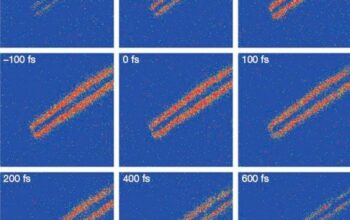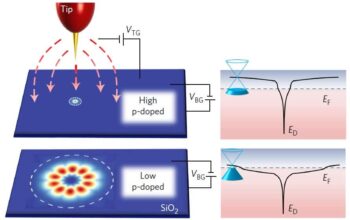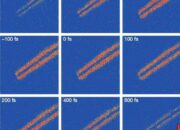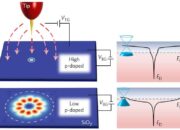Graphene, a monolayer of carbon atoms arranged in a two-dimensional lattice, has gained prominence in scientific circles not merely for its exceptional electrical and thermal conductivity but also for its mechanical prowess. This wonder material, often likened to a ‘superhero’ in the realm of nanotechnology, exhibits remarkable strength and flexibility that surpasses that of steel. The intriguing concept of “graphene bubbles” emerges as an innovative methodology for characterizing shear forces, shedding light on the complex interplay of forces at the micro and nanoscale. This novel approach serves as a powerful tool in understanding material behavior under extreme conditions, unraveling the intricacies of physical interactions that prevail in various systems.
The phenomenon of graphene bubbles arises from the unique properties of graphene itself. When a droplet of liquid is placed on a graphene sheet, it can create a localized deformation due to surface tension, leading to the formation of a bubble. This bubble acts as a sensitive sensor that can respond to external forces with incredible fidelity. Shear forces, which are tangential forces acting parallel to the surface, can significantly affect the deformation behavior of these bubbles. By meticulously studying the dynamics of graphene bubbles, researchers can glean valuable insights into the mechanical characteristics of the material, including its shear modulus—an essential parameter for characterizing stiffness.
In the context of materials science, shear forces dictate how materials respond to applied loads. Understanding how these forces interact with different materials is paramount for engineers and physicists alike. The capacity of graphene bubbles to serve as an effective means for measuring shear forces stem from their innate properties, wherein their size, shape, and deformation correlate directly with the magnitude of the forces applied. The experimental setup typically involves observing the bubble formation and subsequent deflation or deformation in response to various shear forces applied to the graphene substrate. The delicate balance between the properties of the graphene and the external forces creates a symphony of motion, revealing the dance of molecular interactions at play.
One of the most compelling aspects of utilizing graphene bubbles lies in their sensitivity. Graphene’s atomic thickness allows for extraordinary responsiveness to changes in force. The bubbles can detect minute variations, enabling researchers to observe not only the presence of shear forces but also to quantify them precisely. This sensitivity transforms the bubbles into a highly effective tool for exploring the nuances of material behavior, nurturing a deeper understanding of underlying mechanisms at work. Consider the metaphor of a seismograph—just as it captures tremors of the earth’s movements, graphene bubbles chronicle the subtle vibrations induced by shear forces.
Beyond their measurement capabilities, graphene bubbles hold potential for applications that extend into various fields. For instance, in biomedical engineering, the ability to analyze shear forces at microscopic levels could lead to advancements in drug delivery systems. By understanding how shear forces affect the behavior of nano-carriers, researchers can enhance the efficacy of therapeutic agents tailored for targeted delivery within the human body. Similarly, in the realm of nanocomposites, the assessment of shear forces would facilitate the design of materials with tailored mechanical properties, achieving optimal performance in practical applications.
The exploration of shear forces using graphene bubbles is not without its challenges. Experimental limitations often arise, predominantly due to the need for precise control over environmental conditions. Parameters such as temperature, humidity, and the presence of contaminants can significantly influence bubble formation and stability. Moreover, the interpretation of the data gathered from experiments necessitates advanced analytical techniques and modeling to accurately correlate the observed phenomena with the underlying physics. Thus, as researchers delve deeper into this burgeoning field, continued innovation in both experimental and computational methodologies will be crucial.
Furthermore, investigating the scalability of this technique presents another intriguing avenue for research. While the current studies predominantly focus on fundamental physics at nanoscale dimensions, translating these findings to macroscopic systems poses a formidable yet essential challenge. The quest for applying the insights gleaned from graphene bubble dynamics to larger-scale applications will require a nuanced understanding of materials science, engineering, and physics, fostering interdisciplinary collaboration across various fields.
In summary, the study of graphene bubbles as a means of measuring shear forces constitutes a quintessential intersection of material science and fundamental physics. Through the lens of this innovative methodology, researchers gain unprecedented insights into the mechanical properties of materials, elucidating forces that govern behavior at the atomic scale. As the allure of graphene continues to captivate the academic world, its potential applications in diverse fields—from biomedical engineering to materials development—beckon with rich prospects. This journey into the microscopic world of graphene vibrations not only enhances scientific understanding but also paves the way for technological advancements that may redefine the boundaries of innovation. Indeed, the humble yet sophisticated bubble serves as a potent reminder of the intricate forces shaping our physical reality, inviting exploration and discovery in equal measure.










